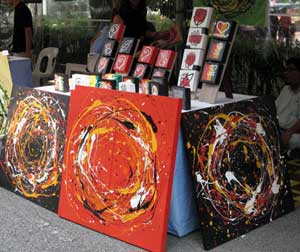It started when I discovered how difficult it is to carry a load of brushes while painting outdoors.
First I tried the traditional bamboo mat brush holders but soon found out that it was not practical. Wet watercolour brushes and bamboo is a bad combination. Moulds grow and destroy expensive brush hairs.
Then I tried using plastic tube brush holders. They were functional - until I started misplacing the cap and losing them. Of course, when I dump wet brushes into them and locked the cap (and forgot to take them out again to dry first before storage), water percolates within the tube. And the brush hair again gets damaged.
So, out of frustration and having tried so many brush holders, not to mention the money spent, I decided to make this from a special waterproof canvas. The outer side is canvas and the inside waterproof rubber-plastic kind of material.
I made it with pockets for individual brushes and depending on the number of brushes I need. It can be folded or rolled, at your convenience with a nice velcro strap to boot.
Because the brushes are not locked within, there is always a constant flow of air through the bag, reducing the risk of fungal/mould growth.
The waterproof material, tough as well, has allowed me more than five years of punishing use. And it has been a great invention - one which I have made for friends and they have introduced it to their artist friends all over. This has been a very functional brush bag indeed! But the nice thing about this invention is that it is handy and you can keep quite a lot of brushes within - more than you will ever need when painting outdoors.
Monday, October 30, 2006
Wednesday, October 25, 2006
Laman Seni - Postponed Until Further Notice

I heard about it a month ago - that the monthly Art Mart, Laman Seni, at the National Art Gallery will be postponed indefinitely. Attempts to get answers have not been successful. However, the first Saturday of October proved the rumours right - the event is no longer held at the compound of the National Art Gallery.
The closure of this art event is a sad thing - especially for artists who had participated in the year-old monthly mart. From my observation, it was also a gathering for artists and for intending collectors to browse for new talents.
But the greatest benefit must have gone to the National Art Gallery for I am sure, the total traffic garnered through all the past Laman Senis, would have been more that what the centre would have attracted since it moved to Persiaran Titiwangsa from its earlier abode opposite the KL Railway Station.
But this must also be said: That the organisation of Laman Seni, unsupervised, would have become yet another pasar malam or a flea market at best.
In the last few installments, one could see that the number of knick-knack traders (those selling anything from sandals to shawls) have overtaken that of artists. Although the definition of art is subjective, I think the organisers should have limited the common, flea-mart traders' participation. They would have drawn crowd, no doubt, but allowing the proliferation of such trading trend would have reduced the status of an art mart to that of a flea market.
Another aspect is the promotion of the monthly event. Except for banners lining the roads to the venue, the monthly mart is not much known about. Publicity came by word of mouth and the fact that the venue is 'out-of-the-way' also did little to help promote it.
Perhaps the organisers have shelved it for a post-mortem, to see how this event can be improved. If this is the case, then it is all well and good for art and the artists colony. Then the monthly art mart can be brought back and made successful this time. The city is not without arts lovers, otherwise the Laman seni would not have survived so long.
The closure of this art event is a sad thing - especially for artists who had participated in the year-old monthly mart. From my observation, it was also a gathering for artists and for intending collectors to browse for new talents.
But the greatest benefit must have gone to the National Art Gallery for I am sure, the total traffic garnered through all the past Laman Senis, would have been more that what the centre would have attracted since it moved to Persiaran Titiwangsa from its earlier abode opposite the KL Railway Station.
But this must also be said: That the organisation of Laman Seni, unsupervised, would have become yet another pasar malam or a flea market at best.
In the last few installments, one could see that the number of knick-knack traders (those selling anything from sandals to shawls) have overtaken that of artists. Although the definition of art is subjective, I think the organisers should have limited the common, flea-mart traders' participation. They would have drawn crowd, no doubt, but allowing the proliferation of such trading trend would have reduced the status of an art mart to that of a flea market.

Another aspect is the promotion of the monthly event. Except for banners lining the roads to the venue, the monthly mart is not much known about. Publicity came by word of mouth and the fact that the venue is 'out-of-the-way' also did little to help promote it.
Perhaps the organisers have shelved it for a post-mortem, to see how this event can be improved. If this is the case, then it is all well and good for art and the artists colony. Then the monthly art mart can be brought back and made successful this time. The city is not without arts lovers, otherwise the Laman seni would not have survived so long.
Images:
Top - Oil paintings being offered at Laman seni.
Bottom - Need sandals? Check them out at Laman Seni.
Book Review: Painting from Photographs

Cameras have become a necessary equipment in an artist's bag and photos have become quite an indispensible tool especially when climatic conditions do not allow one to complete one's paintings outdoors.
Although I know many artists do not like to use photographs for their paintings, I think this "evil" should be accepted as part of technology and the evolution of art form.
In this book Patrick Seslar has shown how one can paint from photographs. Quite interesting are how he captures the lights and shade, including several pieces of good advice on flowers as well.
This is one of the few books which I think can help you understand the nuances of watercolour medium, especially if you paint quite a bit from photographs. Whether the photos serve as your references from stard till finish or as a complement to complete your outdoor sessions.
Subscribe to:
Comments (Atom)

